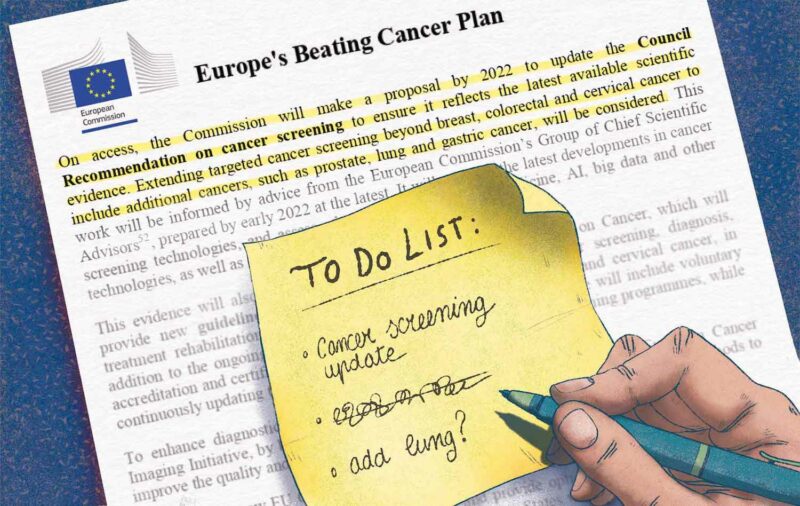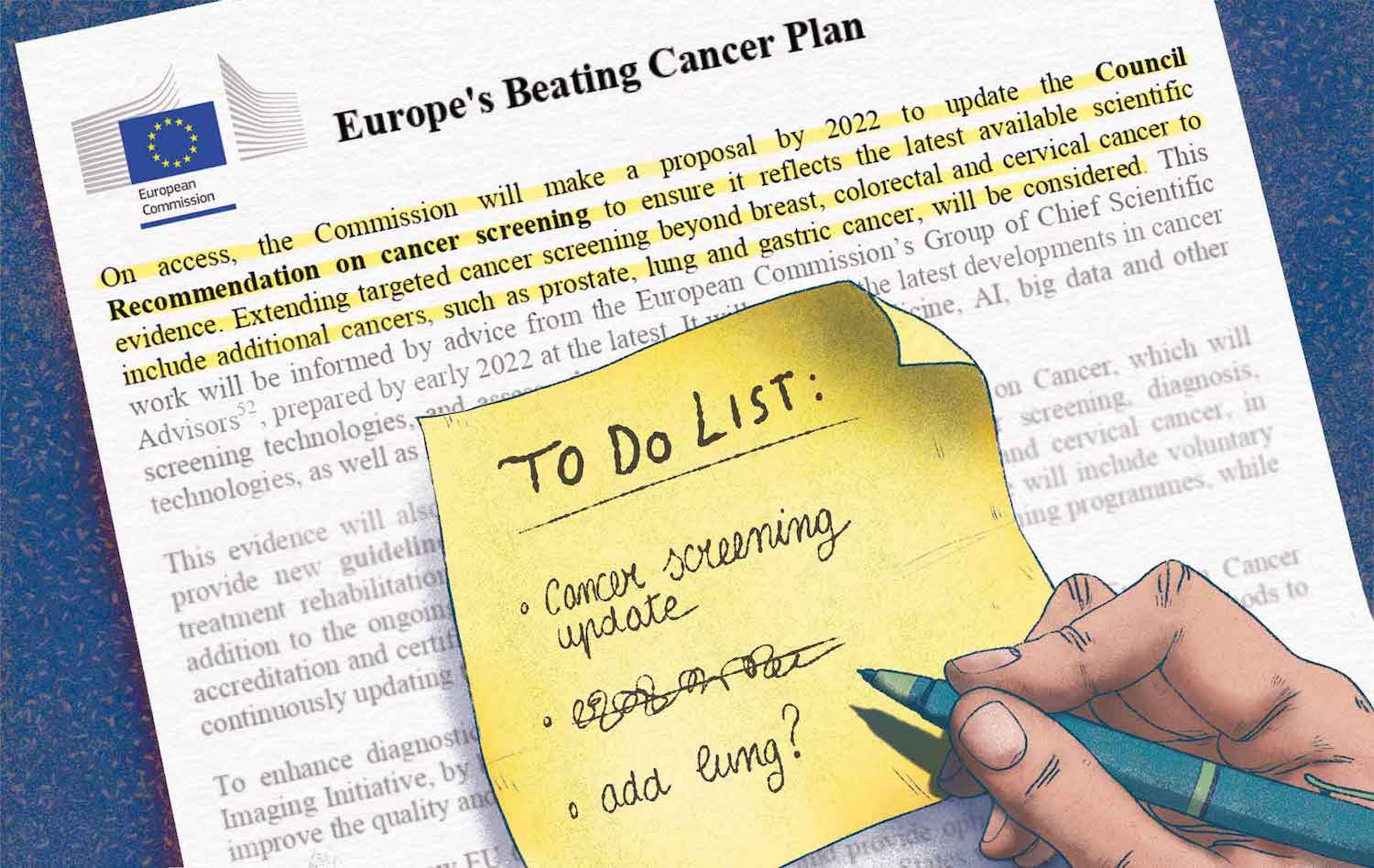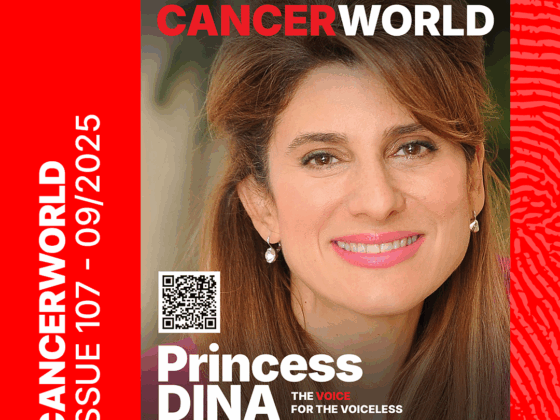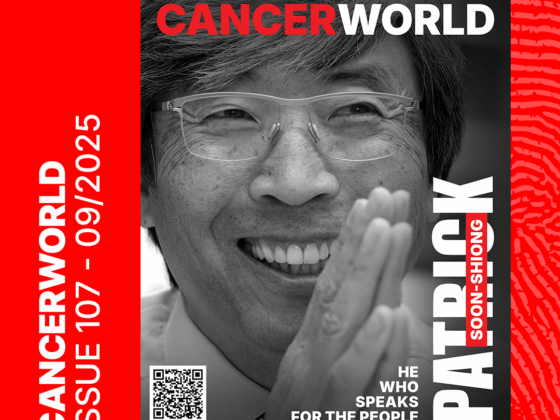If cancer screening policies were driven purely by mortality rates and curability, then lung cancer would long have topped the priority list for population screening programmes. Accounting for almost one in every four cancer deaths in men and almost one in seven for women, lung cancer kills more Europeans each year than any other cancer type. Early diagnosis could make a huge difference ‒ when diagnosed at an early stage, five-year survival rates can be higher than 60%, compared with around 5‒7% for lung cancers diagnosed after they have spread. Given that symptoms suspicious for lung cancer are uncommon in early stages of the disease, the option of systematically screening people at particular risk of the disease would seem to make sense.
Yet while EU guidelines recommend that member states run quality-controlled population screening programmes for cervical, breast and colorectal cancer, so far no such recommendation has been made in relation to lung cancer screening.
The problem, as with all screening programmes, has been finding techniques and strategies that ensure the survival benefit to those whose lung cancers are detected early outweigh the risks of unnecessary radiation and potentially false-positive results run by the great majority of people screened who will not have cancer.
The past two decades has seen important advances in low-dose CT lung screening techniques, which can make detailed images of the lungs with relatively low radiation exposure. In the early 2000s, researchers at Milan’s European Institute of Oncology were at the forefront of developing low-dose CT protocols that were effective at picking up early-stage lung cancers, based on nodule doubling times. Together with protocols to limit the damage of false-positives, progress in identifying and engaging with populations at high-risk for lung cancer, and findings from major trials ‒ most recently the Dutch-Belgian NELSON trial ‒ showing significant survival benefit, this has considerably strengthened the evidence base for setting up risk-stratified lung cancer screening programmes (see Lung Cancer Screening: Time to Act on the Evidence).
The likelihood that lung cancer may soon be added to the EU list of recommended screening programmes has greatly increased as a consequence. Europe’s Beating Cancer Plan, launched in February 2021, committed the European Commission to “make a proposal by 2022 to update the Council Recommendation on cancer screening to ensure it reflects the latest available scientific evidence,” specifically naming lung as one of the cancers to be considered. The Commission is currently awaiting a report it commissioned into the latest evidence on screening from SAPEA, the Science Advice for Policy by European Academies, which is due to be published early in 2022.
In the meantime, a few European countries have started lung cancer screening programmes or pilots of their own. Here, we highlight three such initiatives, being undertaken in Croatia, England and France.
Croatia ‒ Europe’s first population lung screening programme
Croatia, where a national lung cancer population screening programme was launched in October 2020, is the only country in Europe to have fully implemented targeted screening so far.
“As we already have results from the NELSON study showing that screening works, we didn’t see the point in running a pilot,” says Ante Marušić, from the University Medical Centre, Zagreb, in Croatia.
“We decided something urgently had to be done, because the incidence of lung cancer was so high in Croatia”
Goals of the programme include saving more than 500 lives annually by reducing lung cancer mortality by 20% over the coming 5‒10 years, achieving a 50% response rate to screening invitations and raising five-year survival rates for people with lung cancer from 10% to 15%. Such ambitions are especially important in Croatia, a country where in 2014 one in four adults were daily smokers ‒ above the EU average of one in five. “We decided something urgently had to be done, because the incidence of lung cancer was so high in Croatia,” says Marušić. The screening programme is financed by the Croatian Health Insurance Fund, which covers all public sector health services.
Eligibility and referral
Family doctors are central to the scheme’s organisation. They are responsible for identifying patients, during routine visits, who are eligible for referral ‒ a task made easier by databases already available on their patients’ smoking habits relating to other conditions such as COPD and heart disease. “Everyone in Croatia has a dedicated GP, with around 90% of the population visiting their GP at least once a year,” says Marušić.
Eligibility for lung cancer screening is restricted to those aged 50 to 75 years, with a smoking history of 30 pack-years (equivalent to smoking 20 cigarettes per day for 30 years), who are either current smokers or quit smoking within the previous 15 years.
When a GP identifies one of their patients as fitting these criteria, they use a national IT platform to make appointments at one of 16 public sector hospitals around the country. “GPs make the appointment while the patient is still with them in the office, so there’s no getting away,” says Marušić. The additional work involved in motivating patients to take part is recognised with a special payment to GPs.
Screening centres: training and equipment
Screening centres are located such that no-one in Croatia has to travel further than 50 kilometres. To qualify as a low-dose CT scanning centre, hospitals need to be equipped with a 128-slice CT scanner as a minimal technical requirement, and aim for less than 1mSV irradiation. The radiologists who operate the scanners are required to have undertaken a minimum of 300 thoracic CTs per year and to have attended two special training courses. The scan additionally provides quantitative and prognostic information on coronary artery calcification and emphysema. For around 5% of scans, quality control is provided by a centralised radiologist in Zagreb, using computer-aided diagnosis.
Early diagnosis pathway
Regarding results, an important consideration is whether the images are baseline or repeat scans. For those lung nodules where consecutive scans are available, doubling times are used to identify potential tumours. The Croatian service has defined a doubling time of 400 days for a positive diagnosis of a potential tumour; 400‒600 days for an indeterminate diagnosis, and more than 600 days for a benign diagnosis. In patients undergoing a baseline scan, for whom no previous scans are available, the focus is on the volume, with a volume greater than 2,000 mm3 defined as a positive (i.e. suspicious) result. For people with ‘normal’ baseline scans, repeat scans are offered after a year, and then every two years until the age of 75.
Any suspicious findings are referred to one of six nodule clinics, where patients have access to a multidisciplinary team which provides a full work-up that includes full-dose contrast CT, PET scan, bronchoscopy, and transthoracic biopsy.
In the first year the Croatian programme performed 4,500 low-dose CT scans (on 4,000 participants), with a recall rate of 11%, resulting in the detection of at least 30 cancers (including one breast cancer).
An international multidisciplinary quality control committee has been appointed to identify ways to improve the programme
The infrastructure is expected to evolve. An international multidisciplinary quality control committee has been appointed to identify ways to improve the programme. “At the moment we’re keeping things simple, but in future we hope to encourage GPs to play a bigger role in offering smoking cessation services. We are also considering introducing specific risk assessment models for our population, going beyond age and pack-years,” says Marušić. “We especially want to be able to take into consideration the increased risks of our war veterans.”
England: a stepwise pilot approach
England has taken the approach of introducing pilot lung cancer screening programmes, which are being rolled out across England’s National Health Service (NHS) in three distinct phases. The idea of the phased approach is to provide early insights into potential challenges and pitfalls, allowing the programme to evolve as it goes along.
The first phase of the Targeted Lung Health Check programme was launched in February 2019 at 10 locations, the second phase added a further 13 locations, with the third phase planned for April 2022, with an additional 20 locations, bringing the final number of lung cancer screening locations across England to 43. “We’re carrying out continuous evaluation of the projects already running to review their effectiveness and to inform a successful national roll out,” says Richard Lee, the Joint Clinical Lead for the NHS England Targeted Lung Health Check pilot. The hope and expectation, he says, is that the pilots will eventually grow into a national lung cancer screening programme.
The hope and expectation is that the pilots will eventually grow into a national lung cancer screening programme
The concept for the pilots came from the NHS Long Term Plan, launched in January 2019, which set out priorities for NHS reform over the following 10 years. The plan stated the ambition that 55,000 more people would survive their cancer, and that to achieve this aspiration it was necessary to increase the number of cancers diagnosed at an early stage.
The first 10 lung cancer screening pilots were situated in areas in England that were selected for having the highest lung cancer mortality. However, with the third expansion, it is planned that every Cancer Alliance (regional clinical/managerial partnerships that coordinate local cancer pathways) will have at least one project in place. “This will allow existing projects to slowly expand their population coverage, and move into neighbouring areas, until the programme is offered across England,” explains Lee, who is also a consultant respiratory physician at the Royal Marsden NHS Foundation Trust.
Eligibility and referral
In the English pilots, everyone aged over 55 but under 75 who has ever smoked is being invited for the lung health check. GP records are used to identify those eligible, with local advertising also employed to encourage people to take up the offer, and self-refer if they have somehow fallen through the net. The check uses two separate risk calculators ‒ the Liverpool Lung Project risk prediction model and the Prostate, Lung, Colorectal, and Ovarian programme ‒ which take into consideration factors such as smoking history, overall lung health, lifestyle, and family and medical history to calculate a person’s risk of developing lung cancer. Only those considered at high risk are referred on for a low-dose CT scan. Smoking cessation is considered a core part of the lung health check, with current smokers who want to quit being offered brief advice and then referred to a local smoking cessation service.
Screening centres: training and equipment
Each project must follow the Quality Assurance Standards and Standard Protocol, set out by NHS England, which specify the main building blocks required before projects can start to invite participants. The protocol includes the minimum specification for the CT scanner (16-channel multi-detector), and the required workforce. Key roles include the clinical director of the programme, who takes overall responsibility for the safety of patients involved in the programme; the assessor, responsible for selecting and assessing individual referrals for entry; the radiologist, responsible for the low-dose CT; and the clinician, who manages referrals of suspicious scan results to the rapid-access lung clinic. Requirements for both individual professional training and continuing professional development are included in the document.
The majority of the projects use mobile CT scanners that are sited in easy to reach locations, such as supermarket car parks
The majority of the projects use mobile CT scanners that are sited in easy to reach locations, such as supermarket car parks. This change came in the wake of the landmark Manchester ‘Lung Health Check’ pilot, which showed that providing local low-dose CT scanning services close to where people live increased the lung cancer detection rate above any international clinical trial, with one lung cancer detected for every 33 people undergoing a low-dose CT lung scan. “Taking the programme closer to the people we’re trying to reach has been a critical part of our strategy,” says Lee.
Early diagnosis pathway
Results of the initial scan determine the frequency of future scans. Participants with negative baseline scans are reassessed at 24 months; participants with indeterminate findings after 12 months; and participants with significant findings after 3 months. Participants are offered repeat scans until they reach the top end of the eligible age range (75 years).
Even the Covid-19 pandemic did not stall the roll-out for long. At the start of the pandemic all projects were initially paused whilst the risk of Covid-19 was assessed. Adaptations were then made to the way in which the checks were carried out, which involved moving to a virtual model for the initial consultation, which took place over the telephone.
As the Targeted Lung Health Check becomes more established, the organisers hope to offer research opportunities to the different pilots, allowing them to assess whether use of different artificial intelligence programmes and biomarkers will improve the early detection of lung cancer.
The Department of Health estimates that by 2024‒2025, around 1.5 million people in England will have been invited for a lung health check, with a predicted 7,700 cases of lung cancer found at an earlier stage than they would otherwise have been.
France: an exploratory implementation pilot
In France, the CASCADE lung cancer screening pilot has taken the bold decision to focus screening solely on female smokers. The reason for this choice, explains Marie-Pierre Revel, Head of Radiology at Cochin Hospital, University of Paris, is to explore the gender differences revealed in the NELSON lung cancer screening study. The results at 10 years showed that, while screening led to a 24% reduction in lung cancer mortality among men, a reduction of 33% occurred among women. “From CASCADE we hope to find out more about why screening benefits are so much higher in women,” explains Revel, who is leading the CASCADE study.
“We want to evaluate whether our strategy is reproducible in everyday real-life clinical settings”
The pilot is designed to shape any future lung cancer screening programme in France through evaluating the most effective strategies. “Our aim is to be practical. There’s no need to demonstrate mortality reductions from lung screening, as this has already been shown conclusively in NELSON. What we want to evaluate is whether our strategy is reproducible in everyday real-life clinical settings,” says Revel, a radiologist from Cochin University Hospital, Paris.
In France, the decision was taken in 2016 by the Haute Autorité de Santé (National Authority for Health) that they would not introduce organised lung cancer screening due to the high number of false-positives. However, results from the NELSON study transformed the screening landscape. “As well as showing reductions in mortality, NELSON also showed that screening strategies using nodule volume doubling time had few false-positives,” explains Revel.
Eligibility and referral
The CASCADE pilot, which expects to start recruiting in early 2022, aims to enrol 2,400 asymptomatic women, aged between 50 and 74 years, with 25 pack-year smoking histories (equivalent to smoking 20 cigarettes per day for 25 years). To be eligible, women also have to be either current smokers or to have quit smoking within the previous 15 years. The pilot, funded by the Ministry of Health and the Institut National de Cancer (INCa), with a budget of €1.8 million, is focusing efforts on Paris, Rennes, Béthune and Grenoble, four cities that were selected for their diverse socio-economic profiles.
The team took the decision to avoid going through family doctors: “We wanted to reach asymptomatic populations”
To recruit women, the team took the decision to avoid going through family doctors. “People who go to GPs are those with health problems. We wanted to reach asymptomatic populations,” says Revel. Instead, they are evaluating different advertising strategies including using bill boards and TV, radio, and newspaper ads. “We’ll also be looking at whether recruitment is helped by sending out personalised invitations.”
Before undergoing screening, women have an initial appointment with a pneumonologist, who checks whether they meet programme eligibility criteria, and explains the risk/ benefits of undergoing lung cancer screening to those who are eligible. Women are warned that screening can reveal additional health information, including calcium scores (indicating cardiovascular disease) and signs of other lung conditions, such as COPD and emphysema.
The pilot will also explore potential negative psychological effects of undergoing screening, recognising that distress not only relates to receiving positive or indeterminate results, but also includes the patient’s experience prior to screening, during the examination, and while waiting for the results.
Training
A shortage of expert thoracic radiologists to read low-dose CT scans is predicted to be a major problem if lung cancer screening becomes widespread. Investigators are therefore planning to assess whether it is possible to take general radiologists and train them to perform low-dose CT. They are using a programme developed by the European Society of Thoracic Imaging, known as the Lung Cancer Screening Certification Project, which involves webinars, e-learning and workshops. The team plan to assess whether it is feasible for the first reading to be performed by a radiologist who has undertaken the training programme and the second reading to use computer assisted diagnosis. “In NELSON, double reading from expert radiologists was used, which isn’t practical outside a clinical study,” says Revel.
As the pilot develops, the team plan to introduce smoking cessation and combine lung cancer screening with other forms of low-dose CT appropriate for women in the age range 50‒74 years, including screening for breast cancer and osteoporosis.
“We hope our focus will have the additional benefit of highlighting the increase of lung cancer in the female population. This is of vital importance, since lung cancer is now the first cause of cancer death among women in France,” says Revel.
Next steps for Europe
While Croatia, England and France may be ahead of the curve, most member states will be waiting to see what the eagerly awaited SAPEA report to the European Commission has to say about the scientific basis for extending screening programmes to other cancers, including lung.
This report will be important in shaping the decision due later this year on whether ‒ and if so how ‒ to update the EU recommendations on cancer screening, which have remained unchanged since colorectal cancer screening was added in 2003.
Pressure to take a positive approach to adding lung to the existing cancer screening recommendations is coming from the European Parliament’s Special Committee on Beating Cancer (BECA committee), in its report on Strengthening Europe in the fight against cancer published in January 2022. The report “calls for the evidence that proves the positive effect of targeted lung cancer screening on mortality to be recognised; encourages the Council, based on the outcome of the above-mentioned assessment, to consider including lung and prostate cancer screening in the update of the Council recommendation in 2022.” It also calls for “clear and tangible targets to be set for any new cancers that need to be tackled.”
The coming weeks and months will reveal the nature of the scientific advice from SAPEA and the subsequent decision on any updates to the EU recommendations on cancer screening.
But the practical experiences and lessons learned from the diverse examples of cancer screening programmes and pilots already running in some parts of Europe may be as important in persuading ‒ or deterring ‒ other countries to follow suit.
Illustration by Sara Corsi












